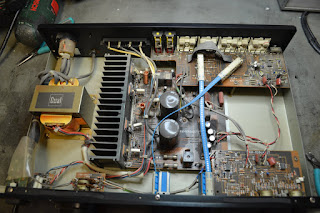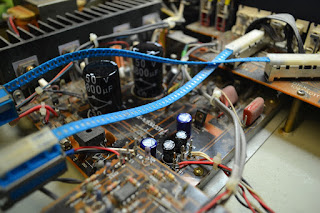5 years ago, I built a rack to house the standards converter and video source equipment in the workshop (you can see that post here)... it's time for a few repairs and a refresh.
It's got a few niggling faults.
1. The DVD player no longer ejects, and sometimes doesn't want to play.
2. There's a couple of channels which no longer work
3. There's quite a lot of crosstalk between channels.
Let's address a few of these...
1) The DVD ...
 First off some disassembly of the rack case, which allows the DVD player to be removed.
First off some disassembly of the rack case, which allows the DVD player to be removed.Powering the player up, and there's nothing on it's output... until after a few minutes the unit powers up, and reports "Bad disc" on it's on-screen display...
 A few screws later, and the lid's off, the tray front removed and the trapped disc released.
A few screws later, and the lid's off, the tray front removed and the trapped disc released.A known good DVD is inserted. At this point it's obvious why the thing won't eject. I suspected a failed tray belt, but that wasn't it... the tray is catching on the front escutcheon. I'll deal with that later. The disc attempts to spin up, fails miserably to get to speed, and then "Bad disc" appears once more.. On the second attempt the player seems to re-start it's firmware...
I check the outputs from the power supply with my multimeter... +5, -12 and +12.. +12 is varying between about 10.5 to 12.5, which may be acceptable. I switch to the 'scope and check the +5V again....
 Woah! That's awful - 40V pk-pk of 50Hz crap riding on the output !
Woah! That's awful - 40V pk-pk of 50Hz crap riding on the output !
The power supply is removed, and a blanket change of all the electrolytic capacitors is performed, to ensure reliability.
 The power supply is replaced, and on powering up, the disc spins up rapidly, and then reports "No Disc" ... hmmm ...
The power supply is replaced, and on powering up, the disc spins up rapidly, and then reports "No Disc" ... hmmm ...The laser pick up is given a gentle clean with some window cleaner (Don't use IPA on any CD or DVD, it damages the coating on the lens), and ....


Bingo, the test pattern DVD fires right up!
 The guilty parties....
The guilty parties....The sticking front tray is resolved by relieving the front a touch with a file... I suspect it's got distorted by the shelf above it in the rack for all those years...
Good, one fault fixed ... on with the next...
2 & 3 - Channels not working and crosstalk.
This is being caused by the mechanical switches failing on the front panel, there was always a bit of cross-talk (one channel seeming to "float" behind the video of another) as the switch does not provide any correct loading, or buffering between channels...
What's needed is a proper video (and, of course audio) multiplexer.
I designed this a while ago in Eagle... thankfully Kicad reads eagle files :) KiCad, the gift that keeps giving :)
There are 8 audio and video inputs.
Each video input is loaded by a 75 ohm resistor, and fed to two MAX4312ESE multiplexing ICs. One outputs the video to a UHF modulator, and one outputs the video to a 625/405 line standards converter. So, under the control of my favourite flavour of microcontroller, the ATMEGA328P, any of the video sources can be sent to either 625 or 405 sources.
The select line of the video multiplexer also feeds two ADG1408Y multiplexers, which switch the audio through to the relevant output device in the same manner. There's a 5532 buffer on the audio output, as there's none in the audio mux, unlike the video mux.
The audio mux requires a negative supply rail, and this is supplied from the microcontroller. A continuous squarewave is output on pin 5 of the micro, is floated by C9, and rectified by the double diode D1 (BAT54S) to provide a "-5V" supply, in reality it's more like -4V.
The micro is controlled by a front panel , which has two push buttons, and a small OLED display.
A PCB was created... not modelled as it was Eagle, but Kicad has a go at it!
 When Kicad imports an Eagle creation, it doesn't seem to cope with the ground plane or component models, but you get the idea...
When Kicad imports an Eagle creation, it doesn't seem to cope with the ground plane or component models, but you get the idea...  ... and duly stuffed. I'll clean that flux up later ;)
... and duly stuffed. I'll clean that flux up later ;) and again, built up... not quite so simple though, as my new display has the power and ground pins reversed from the one I modelled :(
and again, built up... not quite so simple though, as my new display has the power and ground pins reversed from the one I modelled :(
The software is very straight-forward. It acts conditionally on the actions of the select switches on the front panel to increment the channel address selected, and update the display. I used the U8glib library this time out, as it's got some nice fonts, and is quick, if a bit bulky.
The software can be downloaded from my git. https://github.com/andydoswell/video-rack
It will be noted that the hardware supports 8 inputs, and two outputs, but the software doesn't support that many, as I don't need them all! It's a simple task to enable more, if you wish.

Nice font...
So, back to the rack.

Out with the old...

Tidy up the RF wiring a bit. The black box in the bottom is the Aurora 405 line standards converter. The loop of co-ax you can see is a stub filter, as the output from the aurora is very harmonically rich, and the filter eliminates aome of the patterning caused by the harmonics effecting the UHF. What I really need is a low pass filter .... one day.

The UHF modulator (modified to run on DC, see here) is once again disassembled, so I can adjust the channel and sound carrier spacing via two buttons on the front panel. I've just soldered some wires on the existing switches, and made them available to the front panel.

The Cyclone media player, and HDMI converter are mounted on the shelf, and the multiplexer PCB behind that.
The power supply is a salvage 12V 5A supply. This feeds the multiplexer, and the aurora. It also feeds the modulator via a 42 ohm resistor (to give about 8V) , and an eBay 5V buck regulator, which feeds the Cyclone and HDMI converter.

The front panel is marked out...

... and the holes chewed out with my teeth. I do wish my metalwork was better, anyway, it's only for my own consumption!

And it's all wired up ... what a rat's nest!

The back's fitted, and it's all powered up and tested - No cross talk, all the inputs work - oh bliss!
Now, there's a rake of telly's here need fixing ....









































